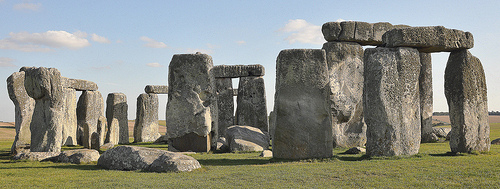Stonehenge
The ancient stone circle of Stonehenge stands on Salisbury Plain in Wiltshire. This iconic archaeological site dates to the Neolithic period, some 4,500 years ago. Nobody knows who built Stonehenge, or what the stone circle was used for, but common theories suggest that the stones were a religious site used for worshipping ancient earth deities, a prehistoric observatory used to map the heavens, or a burial site for high ranking figures of the time.

Whatever its intended use, the construction of Stonehenge was a monumental task, with the smaller Bluestones (weighing 4 tons each) originating in southern Wales, some 150 miles away, and the larger Sarsen stones—weighing around 30 tons each—having to be dragged over 20 miles from the Marlborough Downs.
Folklore adds a mystical allure to the stone circle, with the twelfth century writer Geoffrey of Monmouth, crediting the wizard Merlin from Arthurian legend, as the bringer of the stones. In his account, Merlin and King Uther Pendragon led an expedition to transport the Giants Ring Circle from Ireland, and bring it to Salisbury Plain.
Today Stonehenge, listed as a World Heritage Site by UNESCO, is a major tourist attraction, hosting over one million visitors a year.
Things To Do At Stonehenge
While visitors are no longer permitted to walk among the stones and touch them, you can walk around the outside perimeter of the circle and listen to an audio tour detailing the history of Stonehenge.
The stone circle at Stonehenge isn’t the only attraction on offer. English Heritage, the organisation that manages the site, provides a modern visitors’ centre complete with Neolithic houses to explore, and demonstrations of ancient techniques including flint knapping, rope making and grain milling.
One feature that you won’t want to miss is the interactive ‘Standing in The Stones’ experience. Here, with the help of modern technology, you get to feel what it’s like to be in the stone circle on the Winter and Summer Solstices, and to witness the majestic sunrise on those magical days.
The visitors centre is also home to an exhibition of the treasures recovered from the site and its surrounding area. You’ll see ancient jewellery, pottery, tools, human bones, and the forensic reconstruction of a Neolithic man based on his skeletal remains. And if you’re feeling particularly strong, you can have a go at pulling a replica Sarsen stone.
Discover the Ancient Landscape
The famous stone circle is just one part of a wider landscape that is home to over 350 burial mounds, earth works and other circular ‘henge’ monuments. The larger expanse of Stonehenge covers 6,500 acres and you can take a tour of the landscape on the visitor shuttle, or pick up an orientation guide and follow one of the clearly marked walking routes.
Visitor Facilities at Stonehenge
While you’re exploring the ancient relics at Stonehenge, you can stop off for a bite to eat at the bright and cheery café. All of the food is locally sourced, and the café caters to differing dietary needs. Why not enjoy a beer from the Stonehenge Brewery, or indulge in one of the famous Stonehenge rock cakes?
If you want to bring your own picnic, you can make use of the tables outside the café under the canopy, or enjoy your feast out in the landscape.
Before you head home, pick up a souvenir to remind you of your trip to Stonehenge at the gift shop. The gift shop stocks clothing, jewellery, stationery, homewares, books, and food and drink.
It’s easy to make a visit to Stonehenge last all day, but you can also make it a stop off en route to nearby historic Salisbury, with its magnificent cathedral and museum.

